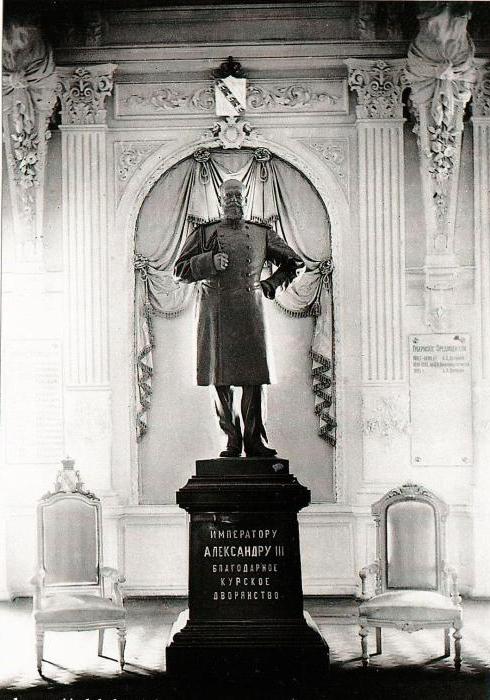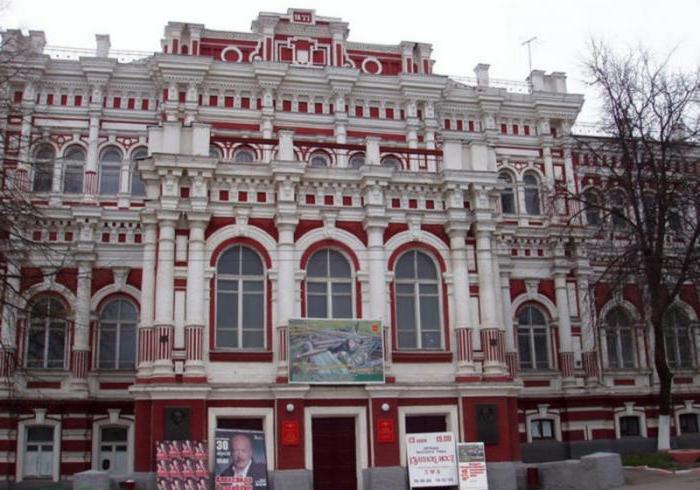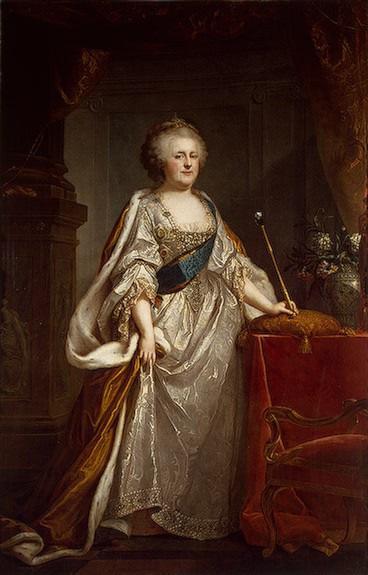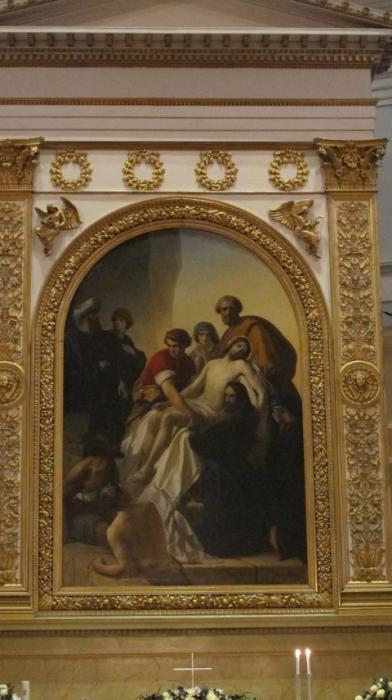The building of the Noble Assembly in Kursk: description, history and interesting facts
Magnificent and majestic building of the NoblemanThe meeting in Kursk is a three-story building of the original architecture of the 19th century. At present it is the House of the State Philharmonic Society of the city of Kursk. What is this building? What is his story? What is the fate of the building of the Kursk House of Officers of the former noble assembly? It is about this historical and mysterious structure that will be discussed in the article.

General description of the building
There is a building near Znamensky Cathedral and is an ornament of the central part of Kursk. Once in his Great Hall balls were held, concerts were given, here Fyodor Chaliapin sang.
It is a three-story corner building,built in the style of eclecticism. It is an architectural monument of national importance. The building was built in the 19th century, it was intended for the Noble Assembly. For all its history, the building suffered twice during the fires, but it was reconstructed.
In different years here were located: The Nobility Assembly, the Palace of Workers, the Revolutionary Military Council, the Museum of Art, the House of the Red Army, the Officers' House. Now the building is on the balance sheet of the State Philharmonic, which has placed its concert venue here.
What is the history of this amazing architectural object?
Prehistory
At the end of the 18th century, on the site of the Noble HouseThe meeting in Kursk was the House of Noble Assembly and the theater adjoining it. In 1805 on the stage of this theater the serf actor Shchepkin MS played, afterwards he became a great Russian actor.
In 1875, a fire broke out in the theater building, which led to the loss of the theater and the whole structure.
Before the October Revolution
On the site of the burned down building in 1877 under the projectarchitect, who remained unknown to history, a new structure was built, which was named after the Noble Assembly. On the third floor of the building was a boarding house for noble children.
But in 1892 in the building of the Noble AssemblyFor some reason, a fire broke out in Kursk, which lasted a whole day, after which the house collapsed. The fire was very strong, it spread to residential areas, burned out a whole residential area consisting of wooden houses.

The building was restored by the architectSlesareva V. G. After the reconstruction and restoration works in the vestibule a marble staircase appeared, which was surrounded by a colonnade. There was also a big hall with a balcony and a stage. The decoration used bronze, mirrors, crystal. Luxurious furniture was arranged.
In 1902, in the Great Hall of the Noble Assembly building in the city of Kursk, a monument to Alexander III was erected, at the opening of the monument there was the Emperor Nikolai II.

In the Great Hall until the beginning of Octoberrevolution, sometimes there were meetings of noblemen, on which they discussed their noble-class problems. In the rest of the time, there were concerts or theatrical premieres: there were opera performances, Shalyapin FI performed in the opera Demon, and in 1911 Plevitskaya NV sang on this stage. Balls and ceremonial occasions were held from time to time.
After the revolution
After the revolution, the building was renamedThe workers' palace, the Great Hall was named the audience of Marx and Engels. The workers began to own the house, meetings and rallies were often held here. The building also housed trade unions, in the halls were organized holidays for workers and peasants. In 1918, the Palace of Workers visited Trotsky, LD. In the Great Hall, many prominent figures of the revolution spoke before the townspeople: Podvoisky NI, Sergeev FA, Bukharin NI

In 1920, in the building of the Palace of Workers (formerthe building of the Nobility Assembly in 1877), the headquarters, command and the Revolutionary Military Council of the Southern Front were located, of which Stalin was a member. In addition to Stalin, the building included the commander of the Southern Front, Egorov AI, and the Chief of Staff Petin N.N.
At present, memorial plaques are installed on the building: Sergeyev FA and Kalinin MI (he was in Kursk and performed in 1920 at the Palace of Workers).
In the 1920s, in the building of the former Nobility HouseThe Museum of Arts was opened. Later, the premises were handed over to the club of railwaymen, from the stage of which in 1927 Mayakovsky VV and Aseev NN read his poems.
In 1929, the Red Army House was opened here, where sports competitions were held, a cinema was opened, artists performed, solemn events and meetings were held.
In 1937, on the first floor of the building was openedStalin's memorial room, there was an exposition devoted to Stalin's stay and work in the city of Kursk, his photographs, drawings, documents. The bust of the leader was installed in the office.
The Great Patriotic War
In 1943, when retreating, the German invadersset fire to the architectural landmark of Kursk. The building of the Noble Assembly of Kursk burnt to the ground, turning into ruins. In such a dilapidated form, the structure existed until the early 1960s.
Post-war time
In the early 60-ies the building was reconstructed,the main architect of the project was Shpara P., during the restoration works the appearance of the historical structure was completely preserved, but a large-scale reconstruction took place inside. The building was now the House of Officers, there was a hall for 900 seats. The officers' house has become an important cultural center of Kursk.

In 1963 a museum was opened in several roomsThe Battle of Kursk, which displays the things of military commanders, schemes, maps, models, documentary and historical materials, samples of weapons, photocopies of reports, medals, orders and much more.
In 1963 the museum was attended by participants of the Kursk battles: Marshal Rokossovsky KK, Lieutenant General Telegin KF, Air Marshal Krasovsky SA, Generals Kozlov MA, Godin GV, Enshin MA, Composer Pakhmutova A.N.
In 1995, in part of the premises of the former buildingNoble Assembly began to work planetarium. It also houses the city library, the book fund of which more than 20 thousand volumes, thematic circles and studios, public and veteran organizations and clubs.

Since 2010, widespread elimination has begunHouse of officers. The closure of the Kursk House of Officers aroused indignation among the townspeople. Despite this, clubs and clubs were closed, the museum stopped its work and began to translate the exhibits in the storerooms, popular pop stars stopped coming to the building to come to the concert in Kursk. But thanks to the personal participation of the governor of the Kursk region, Mikhailova AN in solving this public problem, the building was transferred to the property of the region. The House of Officers housed a concert venue of the State Philharmonic Society of the city of Kursk. In 2012 the building was transferred to the balance of the Philharmonic.
In 2013, a large-scale reconstruction of the building began, which continued until 2015.
Architecture
In architectural terms this is a three-story bricka building built in the style of eclecticism, and combines the styles of Italian Baroque and Renaissance. The building is decorated with horizontal eaves. Its total area is about 6 thousand square meters. The building is part of the architectural complex at the approach to the square.
Instead of concluding
The former house of the Noble Assembly, Noblemanthe Palace of Workers, the House of the Red Army and the House of Officers of Kursk ... History and the legend of our city - this is what the townspeople call this sight. The history of Russia and the history of the building are closely intertwined. The structure has lived an amazing and uneasy fate, but has stood and pleases with its unique appearance of the residents of Kursk and the guests of the city.








